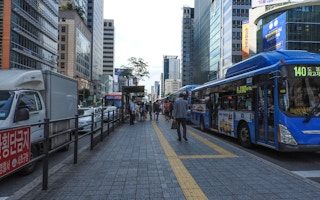In the city of Bandung, in Indonesia, municipal leaders are administering acupuncture. But their patients are not human. The patient is the city itself.
Through a series of small projects – such as carefully placed walkways and parks – they are undertaking a process called “urban acupuncture” that sees cities as living organisms that can be healed by strategically placed pin prick interventions.
Urban acupuncture is just one aspect of urban planning and renewal that is often referred to as developing “livable cities,” which prioritises people over physical features. This is in contrast to how most cities were developed throughout history, with little consideration for their citizens’ quality of life. The livable cities initiative, which is taking off around Asia, is attempting to change that mindset.
Cities are made up of physical features, and how these features are arranged and how they interact with people are key to making cities more livable. Here, digital or “smart” technology can help immensely along with policy and legislative measures that allow digital technology to work seamlessly to connect infrastructure and services to the people.
Smart technology can make cities smarter, more efficient and more livable
Let’s look at urban mobility. Urban roads, vehicles and transportation flows are generally considered arteries and veins of cities. Cities operate at subpar levels with higher costs when they are congested and clogged. Through adopting and implementing digital technologies at different layers, the city’s transportation becomes more intelligent, convenient for citizens and easier to manage.
An example of smart technology being used to make a city more livable can be found in Seoul, where buses and subway cars are equipped with GPS-enabled devices, along with a smart card system that is used to pay the fare. Through these devices, the riders know in advance when their buses will arrive, how occupied or empty the buses are and the estimated time for a rider to get from one point to another by taking different modes of transport.
Transport operators are able to track the frequency and ridership for each route for any given time period. Such data in aggregate can be used to make evidence-based decisions on the addition of buses for certain routes or the modification of the routes. On a longer-term basis, this information can aid transportation planning for urban roads, bus rapid transit systems, or subway construction.
Water supply is another critical area that maintains the health of a city. Through smart metering and source water monitoring systems, water production and supply can be planned by measuring consumption and water availability on a geographical and seasonal basis. Data from utility tariffs also supply evidence of water usage patterns. Online billing and payment systems can make life easier for city residents. In addition, sensors can be used to monitor the flow of water to detect leaks.
“
Digital technology need not be overly complex. It is foremost a matter of knowing what priority urban challenges need to be addressed…
Digital technology also serves those living in more vulnerable or disadvantaged conditions. For elderly single dwellers in cities, a wearable device can be supplied, or apps developed for smart phones, to detect motion and location. The National Council for Aging Care in the United States advocates the use of GPS and smart phone apps to locate seniors with diseases such as Alzheimer’s. These accessible technologies can easily be modified and adopted in developing countries to care for vulnerable populations.
Creating safe cities is another core element of urban livability and can be supported by linking personal mobile devices with CCTVs, or through mobile phone apps designed for women to prevent being attacked. In Seoul for example, an app can be downloaded that once activated will allow networked CCTV cameras in the city to follow, or monitor, the user’s walk home to make sure she arrives safely. Another example is in New Delhi, where an app can be used to report how safe the user feels in a specific location of the city. The information is transmitted to city managers who use the data to improve lighting and other safety features.
Digital technology can be a powerful tool for open and transparent government
Beyond citizen convenience and efficient city management, digital technology can also facilitate open and transparent government, which helps earn the trust of citizens. Citizen participation becomes easier with digital platforms, and some are developed by the government and others by citizens in order to voice opinions, and directly or indirectly partake in processes such as budgeting, planning and as steering committees for urban projects.
In Côte d’Ivoire, for example, web portal Abidjan.net was developed by a private company owned by overseas citizens to access information on what is happening in their home country. The platform evolved to include functions such as the ‘Electronic Petition’, ‘Big Questions’, and Electronic Survey’ pages for citizens to engage in political affairs.
The application of digital technology yields benefits at multiple levels, but its real beauty lies in its ability to collect data. When data are aggregated, mapped or processed, they become powerful tools to understand the city, support informed decision-making and provide the basis for solution development. In Bandung, Indonesia, the Ur-scape planning tool, an open-source urban planning application, consolidates and visualizes data that planners use to identify urban areas most in need of improvement, among other things. In the Ukrainian capital city of Kiev mobile phone and taxi data is used to generate bus routes according to the pattern of movements of the city’s population.
Digital technology need not be overly complex. It is foremost a matter of knowing what priority urban challenges need to be addressed to make the city more livable, how they can be addressed and deriving what value digital technology can add.
Sunghoon Kris Moon is Urban Development Specialist at the Asian Development Bank. This article is republished from the ADB Blog.


















